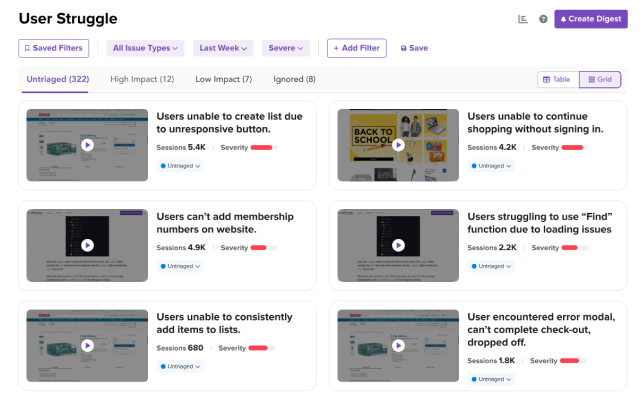

Rosie Allabarton Rosie Allabarton is a freelance writer who specializes in technology, education, design, and careers. She's passionate about driving innovation and change through compelling storytelling.
Table of contents
LogRocket’s Galileo AI watches every session, surfacing impactful user struggle and key behavior patterns.
A heuristic evaluation is a relatively simple method of assessment used by teams of UX experts to help uncover issues and enhance designs for greater overall usability. Unlike other UX design methodologies, a heuristic evaluation is lean, fast, and requires minimal resources, external input, or team members, making it a popular choice among smaller companies and teams.

If you’re new to heuristic evaluations, then you’re in the right place. In this article, we’re going to be giving you all the information you need on the subject before running you through how to conduct your own heuristic evaluation successfully. We’ll also throw in our own tips and tricks as we go.
Here’s what we’ll be covering:
A heuristic evaluation is essentially a quick and efficient problem-solving or decision-making methodology used by UX designers to assess how usable a design, product, or service is and to gain an understanding of how well-aligned it is to commonly-acknowledged usability principles. The process sees UX designers directly assessing the usability of the product against a predefined list of criteria, known as heuristics.
In UX design, a “heuristic” is simply a practical approach to problem solving. This approach is not designed to be perfect but is rather a sufficient measurement or gauge to support and inform teams who are trying to achieve a particular objective.
The Nielsen Norman Group, the UI and UX consulting company founded by usability pioneers Jakob Nielsen and Don Norman, define a heuristic evaluation as “a usability engineering method for finding the usability problems in a user interface design so that they can be attended to as part of an iterative design process. Heuristic evaluation involves having a small set of evaluators examine the interface and judge its compliance with recognized usability principles (the ‘heuristics’).”
When you begin to research UX heuristics, you’ll find that although there’s a lot of crossover, not everybody uses the same exact set of principles for conducting a heuristic evaluation.
As these principles should only be considered a rule of thumb, rather than specific guidelines, you can choose whichever principles are most aligned with your current UX practice. In this article, however, we’re going to be following the ten usability heuristics recommended by The Nielsen Norman Group, which is the criteria most commonly used and the one you will most likely be expected to be familiar with when working in a UX design team.
Here are some alternative usability heuristics that you may wish to explore.
As leaders in the field, the Nielsen Norman Group’s ten usability heuristics have become the industry standard for heuristic evaluations. Let’s take a look at each one in detail so you’ll know the glasses you’ll be looking through when conducting your own assessment.
The first of the Nielsen Norman Group’s ten heuristics is about clear communication between the system and the user. The user should be informed by the design of the system’s current status, receive proper feedback in a timely manner, and be able to expect predictable interactions.
Familiarity is a key concept in user experience design. This principle recommends that the design should be familiar to the user, use recognizable language and concepts, and align with real-world conventions.
The goal should be for data to be displayed logically and intuitively to users so they can easily find what they need and remember how to interact with the design in future.

![]()
Learn more →
As humans, we make mistakes all the time. Designers need to therefore ensure that errors can be quickly corrected or undone before they become permanent or lead to more serious consequences that are harder to rectify.
A clearly signposted exit from a situation enables users to stay in control of what they are doing and avoid negative experiences with the system.
Following on from the familiarity principle, consistency is key to building trust with users.
In addition to staying consistent within an interface itself, designers should seek to follow industry conventions too, adopting similar language and actions to others in the field. After all, it’s a user’s interactions with sites other than yours that will form their expectations, so study what your competitors are doing and align your own design with the standard convention.
Prevent users from making errors by offering them the option to confirm their choices before they’ve been made permanent. This can be done with pop-ups or checkboxes that give the user a moment to reconsider the action they’ve taken.
Of course, creating a design that makes errors less likely to happen in the first place is the ideal, which designers can do by improving confusing navigation or labeling or by completely removing elements which don’t align with users’ expectations or mental models.
It’s important that users aren’t expected to remember the elements of an interface, the previous pages they’ve visited, or the actions they’ve taken. If they need input to continue towards their goal, that information should be clearly visible to them at every stage of the journey with the help of clear labeling, content organization, and menus. Keep the mental load low and make elements easily recognizable to users as they move through the interface.
You should create processes that are usable for those of varying levels of expertise. In addition, enabling users to tailor actions they perform regularly will increase the efficacy and enjoyment of interface interaction and encourage user loyalty to a brand, product, or service.
Simplicity is key to a positive user experience. For this reason, designers should only include information, elements, and actions which are strictly necessary to the completion of the user’s goals. Any additional information will only distract the user and reduce the visibility of the elements they are actively seeking.
Errors should be highlighted to the user in familiar and simple language that state the nature of the problem clearly and suggest how it can be solved. Images to support the messaging should also be used in order to provide the user with an immediate understanding of what has occurred.
Designers should avoid jargon and consider using bold, red lettering (traditionally associated with errors) to get the message across quickly.
In an ideal world, your interface shouldn’t need any additional notes or documentation. However, not every system is the same as the next and sometimes it’s useful to provide users with additional information to help them reach their goals effectively. What’s key here is the search function: make the content easy to search through, avoid jargon, and keep the user’s goals in mind.
A heuristic evaluation is a key tool for any UX design team when trying to overcome a design challenge, minimize design deficiencies, or optimize the usability of a product or service. The process itself contains numerous design, collaboration, and financial benefits, which makes it a popular tool for UX teams at startups or freelance UX designers hoping to enhance or fix a design. Here are some of the key advantages to running a heuristic evaluation.
A heuristic evaluation is an effective tool for identifying usability issues with a product or service at speed. With the process recognized as an effective gauge, rather than a perfect process or approach, it can be performed over a relatively short period of time and with few resources and team members, enabling deficiencies to be identified at an earlier stage in the UX design process than might have been the case had a more “perfect” approach been used.
Due to the list of principles used to measure the product’s usability against, the team is clear about what the outcome of the process should be and are therefore more likely to be aligned on its purpose and goals.
This criteria also makes it easier for the UX team to get buy-in from other stakeholders in both performing the heuristic evaluation and investing in any changes the results of the evaluation indicate need to be implemented.
Unlike other UX design methodologies, which can take time, resources, technology, or numerous team members, a heuristic evaluation is inexpensive to implement and doesn’t involve the recruitment of candidates in order to be effectively conducted.
The individual performing the evaluation can simply act as the end-user themselves. The cost/benefit ratio of a heuristic evaluation is therefore significantly better than other, more time-consuming UX methodologies looking to identify usability issues.
As there is a limited number of heuristics for a UX designer to learn, getting to know each one and then applying them to a design quickly becomes second nature. In stark contrast to the sometimes lengthy processes a UX team undertakes during product development — that might require extensive documentation or support to perform — a designer really just needs to know these ten heuristics really well, and combine them with some simple steps, in order to complete a successful evaluation.
Although a heuristic evaluation has specific, recommended steps, the principles (or “heuristics”) that form the backbone of a heuristic evaluation can be applied to every aspect of a UX designer’s work on a product or design. Whether it’s improving an entire product or just assessing a feature, prototype, or wireframe, the heuristics needed to optimize the user experience and solve challenges remain the same.
Now that we’ve got a good understanding of the criteria commonly used by UX designers to assess a product, feature, or design element, let’s dive into the steps you need to take to conduct a heuristic evaluation.
Limiting the scope of your evaluation will make the overall assessment easier to carry out and ensure that you stay in control throughout. It will also assist in your communications with the team about what is expected of them (which you’ll discuss during the briefing) and keep everyone aligned.
You’ll need to ask:
As we’ve mentioned, not everyone uses the same set of heuristics as we’ve chosen here. Although there’s significant crossover between different schools of thought, you might find that some principles align better with your methodology than others.
For this reason, it’s worth researching the sets of heuristics that have been put together by different designers and companies. If your product or design is similar to theirs, it might be worth considering following their heuristics, too.
When putting together the team who will perform the heuristic evaluation, it’s important to prioritize usability experts and those with significant domain experience within your particular industry. You’ll want to aim for between three and five experts on your team.
Be sure to include:
The more evaluators you have with different skill sets on your team, the more usability issues you are likely to uncover. However, you should avoid having more than ten experts on your team as such a large number is unlikely to yield better results than when the team is kept lean and can make the process longer than it should be.
Before you start the evaluation, you’ll want to ensure that all the evaluators are on the same page, from aligning expectations of the evaluation itself, to how success is defined, and what each individual’s role will be during the session. It might be helpful to see this briefing session as a mini kickoff meeting where you communicate what you’ve decided in the previous steps; for example, the heuristics you’ve decided to use, the scope of the project, and the elements that should be focused on.
The briefing session is also an opportunity to ask clarifying questions and share an outline of activities and tasks. It’s at this stage that you may want to assign specific tasks to individuals with relevant experience. By the end of the session, everyone should know what’s expected of them and their teammates.
Consider implementing a system for evaluation that everyone agrees on; for example, you might choose a traffic light evaluation system with green representing good practice and red representing a major issue.
The first phase of the evaluation begins with each evaluator going step-by-step through each of the tasks or activities that they have been assigned during the briefing as though they are the target user. This means they will be looking for what speaks to that user, making decisions that the user is likely to make, and keeping in mind the goals or priorities of the user as they interact with each element.
During the walkthrough, each evaluator is looking to uncover user challenges and usability issues based on the chosen set of heuristics. When an issue is found, the evaluator notes the exact location of it within the design and assesses its severity (using the evaluation system).
This final stage of the evaluation brings all the evaluators back together to share their findings. As part of the debrief, one member of the group should write down all the issues in one shareable document so that each member of the group has a complete list.
Because the purpose of the evaluation is more problem finding than problem solving, solutions should not necessarily be expected at this stage. However, if the evaluators come up with solutions during this session, be sure to make a note of them too.
Whether you choose to present your findings using a slideshare or a shared Google Doc, be sure to present them in person to other teams and stakeholders as this will help get buy-in from those who weren’t part of the evaluation but who are deeply invested in the design and the product. Presenting in person will also help you to justify and add detail to your findings which may be missing from a report that is simply shared via email.
In this tutorial, we’ve taken a deep dive into what a heuristic evaluation is and how you and your team can successfully perform this simple assessment to enhance your product and reduce usability issues. We’ve also seen what direct benefits teams and companies can experience when adopting this approach; from the speed with which it can deliver results to its cost effectiveness.
If you’d like to learn more about conducting a heuristic evaluation, I recommend checking out the UX Methods podcast episode on heuristic evaluation or reading case studies like this one for Chase bank.
LogRocket lets you replay users' product experiences to visualize struggle, see issues affecting adoption, and combine qualitative and quantitative data so you can create amazing digital experiences.
See how design choices, interactions, and issues affect your users — get a demo of LogRocket today.